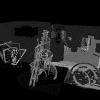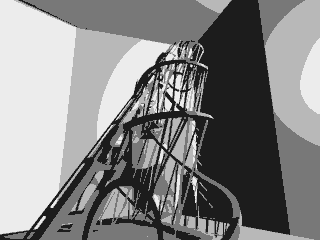Virtual gallery of spatial forms and compositions: Existing, unrealized and lost.
The purpose of this project is to create a virtual gallery of vanguard sculpture, three-dimensional art objects and compositions. All models will be reconstructed and animated in three-dimensional computer graphics. Music/sound support will accompany each composition. The exhibits will be mounted in an interior space designed by the author on the computer, and it will be possible to travel inside these interiors in real time, looking at and manipulating forms from different perspectives.
One will be able to choose a model for closer inspection to learn its history, context of creation and artistic purposes. Texts relating the details of the device, design and methods of construction will also accompany the works, as well as a description of the model's construction in the computer graphics program. Anyone can access the exhibit in order to transform it or change its animation and sound settings at one's discretion.
The project is based on existing, unrealized and lost objects--the past and present of the Russian vanguard. The first halls of the exposition will be devoted to the fathers/founders of vanguard currents of the beginning of the 20th Century, volume compositions created by artists of constructivism, suprematism and architectural propaedeutics. Three-dimensional copies of compositions of Tatlin, Rodchenko, Malevich and Lissicskij have already been completed. Further representations of the widest spectrum of artistic directions, including modern vanguard sculpture, will find volumetric life in virtual space.
The vanguard, and, in particular, the Russian vanguard, retains a constant cultural value, creating interest all over the world. A virtual gallery enables one to experience historical models come alive so that "pictures" can be accessed in a form that will allow further work with them. That will be interesting not only for beginning artists but also for professional designers.
News of the gallery's creation, invitations to visit it and to become a participant will be placed in art publications and in computer and multimedia publications, as well as news of updates, best exhibits and messages from online conferences associated with the project. Computer networks will allow users from all over to view the project and participate in an electronic dialogue about the project. Artists engaged in vanguard sculpture and wishing to present virtual copies of their works can join in, as can artists engaged in three-dimensional computer graphics and animation, artists interested in currents of modern art, art critics, experts in multimedia, modern composers, etc. In addition, the project will include the issue of a CD-ROM with the contents of the museum.
Internet technology has advanced considerably in the last few years. Relevant to this project is the so-called "Second Web," based on Virtual Reality Modeling Language (VRML), the language that describes the construction of three-dimensional space and allows for the uniqueness of the present project. This technology allows the components listed above to be assembled for the first time. Up to now, virtual galleries were simply libraries of flat, two-dimensional images. This interactive gallery would allow the synthesis of the best traditions of art for the first time: volumetric models, color, animation and sound. And it would allow visitors to travel through gallery spaces in real time. Comments on the history of the works, rules of composition and instructions on using the toolkits of the computer software programs will be a part of the project.
The project will seek to create widely accessible space for dialogue, leading to acquaintance with and the mutual accumulation of cultural experiences in the sphere of arts, and the popularization of modern and historical currents in art. Models which exist only in drawings and photos will be restored through "Lost in time" exhibitions, the contents of which can be a valuable educational resource.
The project seeks to locate the basis of the problems and decisions behind representational expressiveness. Acquiring the knowledge of how to create effective images and the effects they have on us, the knowledge of existing styles, through composite prototypes is as important as the knowledge of syntax and punctuation. One can speak about the gallery as a prototype storehouse of images, of "Marks of time," created in the best traditions of art, synthesized through volume, color, movement and sound.
The author of this project has begun a serious exposition of models of the vanguard from the beginning of this century. At that time, artists spoke about the creation of a prototype alphabet of expressive means--color, lines, simple geometrical figures. The components of this alphabet would be simple and elementary, just as the phonetic units of our spoken alphabet. It was only required to collect these means together and comprehend them. The research activity on this alphabet continues to this day, and by visiting our gallery, one can be connected to this activity by creating compositions from the simple geometrical forms, allowing one to comprehend his or her own sensations as they are derived from the gallery's compositions.
Another current of thought popular at the beginning of this century was the synthesis of arts and synthetic images. The problem of the isolation of computer technologies from the art prototypes produced by a culture is an important one. Therefore, a part of this project will be to create a special educational studio devoted to teaching fine art through computer graphics technology. Textbooks on computer graphics usually train people to use the tools of the software outside the context of artistic activity. The result is that a person can learn to use the programs but not how to create art in an expressive or competent way.
Although the tools of computer graphics programs simulates in many respects real representational techniques, work with real forms remains, for the most part, a sphere not mastered by computer technologies. As such, a part of the educational studio will contain texts designed to acquaint visitors with professional concepts of composition, style, form, proportions, relationships of parts to the whole composition, contour, stain, symmetry, asymmetry, contrast, etc.

